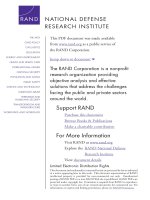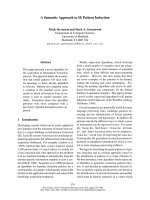A Strategic Approach to Joint Officer Management ppt
Bạn đang xem bản rút gọn của tài liệu. Xem và tải ngay bản đầy đủ của tài liệu tại đây (3.7 MB, 249 trang )
This document and trademark(s) contained herein are protected by law as indicated
in a notice appearing later in this work. This electronic representation of RAND
intellectual property is provided for non-commercial use only. Unauthorized
posting of RAND PDFs to a non-RAND Web site is prohibited. RAND PDFs are
protected under copyright law. Permission is required from RAND to reproduce,
or reuse in another form, any of our research documents for commercial use. For
information on reprint and linking permissions, please see RAND Permissions.
Limited Electronic Distribution Rights
Visit RAND at www.rand.org
Explore the RAND National Defense
Research Institute
View document details
For More Information
This PDF document was made available
from www.rand.org as a public service of
the RAND Corporation.
6
Jump down to document
THE ARTS
CHILD POLICY
CIVIL JUSTICE
EDUCATION
ENERGY AND ENVIRONMENT
HEALTH AND HEALTH CARE
INTERNATIONAL AFFAIRS
NATIONAL SECURITY
POPULATION AND AGING
PUBLIC SAFETY
SCIENCE AND TECHNOLOGY
SUBSTANCE ABUSE
TERRORISM AND
HOMELAND SECURITY
TRANSPORTATION AND
INFRASTRUCTURE
WORKFORCE AND WORKPLACE
The RAND Corporation is a nonprofit
research organization providing
objective analysis and effective
solutions that address the challenges
facing the public and private sectors
around the world.
Purchase this document
Browse Books & Publications
Make a charitable contribution
Support RAND
This product is part of the RAND Corporation monograph series.
RAND monographs present major research findings that address the
challenges facing the public and private sectors. All RAND mono-
graphs undergo rigorous peer review to ensure high standards for
research quality and objectivity.
Margaret C. Harrell, Harry J. Thie,
Sheila Nataraj Kirby, Al Crego,
Danielle M. Varda, Thomas Sullivan
Prepared for the Office of the Secretary of Defense
Approved for public release; distribution unlimited
NATIONAL DEFENSE RESEARCH INSTITUTE
A Strategic
Approach to
Joint Officer
Management
Analysis and Modeling Results
The RAND Corporation is a nonprofit research organization providing
objective analysis and effective solutions that address the challenges facing
the public and private sectors around the world. RAND’s publications do
not necessarily reflect the opinions of its research clients and sponsors.
R
®
is a registered trademark.
© Copyright 2009 RAND Corporation
Permission is given to duplicate this document for personal use only, as long
as it is unaltered and complete. Copies may not be duplicated for commercial
purposes. Unauthorized posting of RAND documents to a non-RAND
Web site is prohibited. RAND documents are protected under copyright law.
For information on reprint and linking permissions, please visit the RAND
permissions page ( />Published 2009 by the RAND Corporation
1776 Main Street, P.O. Box 2138, Santa Monica, CA 90407-2138
1200 South Hayes Street, Arlington, VA 22202-5050
4570 Fifth Avenue, Suite 600, Pittsburgh, PA 15213-2665
RAND URL:
To order RAND documents or to obtain additional information, contact
Distribution Services: Telephone: (310) 451-7002;
Fax: (310) 451-6915; Email:
Library of Congress Cataloging-in-Publication Data is available for this publication.
978-0-8330-4750-2
The research described in this report was prepared for the Office of the
Secretary of Defense (OSD). The research was conducted in the RAND
National Defense Research Institute, a federally funded research and
development center sponsored by the OSD, the Joint Staff, the Unified
Combatant Commands, the Department of the Navy, the Marine Corps,
the defense agencies, and the defense Intelligence Community under
Contract W74V8H-06-C-0002.
iii
Preface
Several recent studies, including one authorized under the 2002
National Defense Authorization Act, have indicated the need for the
U.S. Department of Defense (DoD) to update the practice, policy, and
law applied to joint officer management and Joint Professional Military
Education (JPME) to meet the demands of a new era more effectively.
In 2003, DoD asked the RAND National Defense Research Insti-
tute to undertake an analysis that would provide overarching guidance
on officer education and development in joint matters. e results of
that effort were documented in Framing a Strategic Approach for Joint
Officer Management
1
and in a companion report, Framing a Strategic
Approach for Reserve Component Joint Officer Management.
2
One of the goals of the current project, which builds on the ear-
lier effort, is to operationalize this strategic approach for joint officer
management in the active component through extensive data analysis
and complex modeling. As a lead-in to this effort, in summer 2005, the
research sponsor and another organization conducted the Joint Officer
Management Census survey (the JOM survey) of individuals serving in
billets that were likely to either require prior joint experience or provide
1
Harry J. ie, Margaret C. Harrell, Roland J. Yardley, Marian Oshiro, Holly Ann Potter,
Peter Schirmer, and Nelson Lim, Framing a Strategic Approach for Joint Officer Management,
Santa Monica, Calif.: RAND Corporation, MG-306-OSD, 2005.
2
Harry J. ie, Margaret C. Harrell, Sheila Nataraj Kirby, Al Crego, Roland J. Yardley,
and Sonia Nagda, Framing a Strategic Approach for Reserve Component Joint Officer Manage-
ment, Santa Monica, Calif.: RAND Corporation, MG-517-OSD, 2006.
iv A Strategic Approach to Joint Officer Management: Analysis and Modeling
officers with joint experience. An earlier report
3
provided an overview
of the survey responses, including the extent to which officers believe
that their assignments provide them with joint experience or require
them to have prior joint education, training, or experience.
is report uses data from the 2005 JOM survey to examine fur-
ther the demand for and supply of “jointness” in billets. ese billets
include those on the current Joint Duty Assignment List (JDAL), for-
mally recognized in law as providing joint experience and thus eligible
for joint duty credit; those in external organizations with some billets on
the JDAL; and internal service billets that are currently excluded from
consideration for joint duty credit. e report focuses on three areas:
(1) analyzing the characteristics that measure “jointness” of a billet and
using that analysis to identify billets that could be recommended for
inclusion in the JDAL; (2) determining whether sufficient numbers of
officers with joint education, training, and experience are likely to be
available to satisfy DoD’s needs; and (3) exploring whether and how
the experiences of selected communities of officers—for example, those
assigned to billets dealing with acquisition matters—differ from those
of their peers. As such, this report should be of particular interest to
military personnel managers dealing with joint officer management
issues or particular communities of officers. Findings from the analy-
ses were provided to the sponsor and used in developing DoD’s new
strategic plan for joint officer management and JPME, issued in April
2006,
4
and the implementation plan for the new joint officer quali-
fication system, issued in March 2007.
5
Because the work presented
here predates the new system now being implemented, we present the
recommendations as they were initially provided to the sponsor. Many
of these recommendations have been incorporated into the new joint
officer qualification system.
3
Sheila Nataraj Kirby, Al Crego, Harry J. ie, Margaret C. Harrell, Kimberly Curry
Hall, and Michael S. Tseng, Who Is “Joint”? New Evidence from the 2005 Joint Officer Man-
agement Census Survey, Santa Monica, Calif.: RAND Corporation, TR-349-OSD, 2006.
4
DoD, Strategic Plan for Joint Officer Management and Joint Professional Military Educa-
tion, 2006.
5
DoD, Joint Qualification System Implementation Plan, March 2007.
Preface v
is research was sponsored by the Under Secretary of Defense
for Personnel and Readiness. It was conducted within the Forces and
Resources Policy Center of the RAND National Defense Research
Institute, a federally funded research and development center spon-
sored by the Office of the Secretary of Defense, the Joint Staff, the Uni-
fied Combatant Commands, the Department of the Navy, the Marine
Corps, the defense agencies, and the defense Intelligence Community.
e principal investigators are Harry ie and Margaret Harrell. Com-
ments are welcome and may be addressed to Harry ie at harry_thie
@rand.org and to Margaret Harrell at
For more information on RAND’s Forces and Resources Policy
Center, contact the Director, James Hosek. He can be reached by
email at ; by phone at 310-393-0411, extension
7183; or by mail at the RAND Corporation, 1776 Main Street, Santa
Monica, California 90407-2138. More information about RAND is
available at www.rand.org.
vii
Contents
Preface iii
Figures
xi
Tables
xv
Summary
xix
Abbreviations
xxxiii
CHAPTER ONE
Introduction 1
Background and Purpose of Project
1
Purpose and Organization of Report
4
CHAPTER TWO
Findings from the 2005 Joint Officer Management Census Survey 7
Background
7
Categorization of Billets
8
Caveats
9
Typical Metrics of “Jointness”
10
Tasks Performed During a Typical Workweek
10
Frequency and Number of Interactions with Non-Own–Service
Organizations and Personnel
14
Supervision of Billet by Non-Own–Service Personnel
14
Joint Experience Provided by a Billet
17
Need for Joint Professional Education and Prior Joint Experience
for Billet Assignment
20
Summary
22
viii A Strategic Approach to Joint Officer Management: Analysis and Modeling
CHAPTER THREE
Identifying Attributes of “Joint” Billets 23
Data
24
Classification Methods
31
Classification and Regression Trees
31
Heuristic Approach
36
Factor Analysis
38
Basic Concepts
39
Results
41
Using the Nine Factors to Characterize Billets
46
Logistic Regression Analysis
47
Results: JDAL Versus Service-Nominated Billets
49
JDAL Versus External Organization Billets
53
Service-Nominated Billets Classified as JDAL Billets
56
JDAL Billets Classified as Service Billets
62
Non-JDAL Billets in External Organizations and JDAL Billets
65
Summary
74
CHAPTER FOUR
Determining Whether ere Are Sufficient Joint-Experienced
Officers to Meet the Demand for em
81
Background and Approach
81
Management Frameworks for Joint Officers
82
Managing Leader Succession
82
Managing Competencies
83
Managing Skills
83
e Demand for Joint Officers
84
e Supply of Joint Officers
86
Case Studies
87
Demand and Supply Inputs to the Modeled Analyses
88
Management Frameworks Input to the Modeled Analyses
90
Output of the Analyses: Can ere Be Sufficient Numbers of
Joint-Experienced Officers?
94
Sufficiency of Joint-Experienced Officers Depends on Demand
96
Contents ix
CHAPTER FIVE
Billets Dealing with Acquisition Matters 103
Defining Acquisition Billets
103
Analysis of Acquisition Billets Using Definition A (Joint Program
Office Billets)
106
Descriptive Profile of Acquisition/Non-Acquisition Billets
106
Typical Metrics of Jointness
110
Summary of Findings: Definition A
119
Analysis of Acquisition Billets Using Definition B (Based on Billet
Functions and Required Certification Information)
121
Descriptive Profile of Acquisition/Non-Acquisition Billets
121
Typical Metrics of Jointness
124
Summary of Findings: Definition B
135
CHAPTER SIX
Other Considerations 137
Acculturation
137
Duration (Tenure)
138
Recency
138
Intensity
138
Depth of Understanding
140
Expanding Joint Experience Credit
140
e Value of Joint Professional Military Education
141
CHAPTER SEVEN
Conclusions and Recommendations 143
Conclusions
143
Characteristics at Measure Jointness
143
Meeting Demand for Joint-Experienced Officers
144
Functional Categorizations
145
Recommendations
145
APPENDIXES
A. Incumbent and Non-Incumbent Questionnaires, 2005 Joint
Officer Management Census Survey
149
B. Model Description
193
Bibliography
207
xi
Figures
3.1. A Classification Tree for Classifying Billets as JDAL,
Non-JDAL in External Organization, and Service-
Nominated
33
5.1. Percentage of Officers Receiving Credit for JPME I,
JPME II, and JSO Status, by Acquisition/JDAL Billet
Category (Definition A)
109
5.2. Categorization of Billets by Primary Focus of Job, by
Acquisition/JDAL Billet Category (Definition A)
110
5.3. Percentage of Billets Supervised by One or Two Non-
Own–Service Supervisors, by Acquisition/JDAL Billet
Category (Definition A)
111
5.4. Percentage of Officers Performing One or More “Highly
Joint” Tasks, by Acquisition/JDAL Billet Category
(Definition A)
112
5.5. Percentage of Officers Reporting at ey Drew on
eir Primary Specialty Most or All of the Time in
Carrying Out Assignment, by Acquisition/JDAL Billet
Category (Definition A)
113
5.6. Percentage of Officers Ranking Service Competencies,
Joint Experience, and Functional Expertise as “Most
Important” in Carrying Out Assignment, by
Acquisition/JDAL Billet Category (Definition A)
114
5.7. Percentage of Officers Agreeing or Strongly Agreeing
at Civilians or Officers from Another Service Could
Carry Out Assignment Effectively, by Acquisition/JDAL
Billet Category (Definition A)
115
xii A Strategic Approach to Joint Officer Management: Analysis and Modeling
5.8. Percentage of Officers Reporting at JPME II Was
Required or Desired for the Billet, by Acquisition/JDAL
Billet Category (Definition A)
116
5.9. Percentage of Officers Reporting at Prior Joint
Experience Was Required or Desired for the Billet, by
Acquisition/JDAL Billet Category (Definition A)
117
5.10. Median Number of Types of Knowledge Required and
Provided by the Billet, by Acquisition/JDAL Billet
Category (Definition A)
118
5.11. Percentage of Officers Agreeing or Strongly Agreeing
at the Billet Provides Significant Multiservice
Experience, by Acquisition/JDAL Billet Category
(Definition A)
119
5.12. Percentage of Officers Agreeing or Strongly Agreeing
at the Billet Provides Significant Multinational
Experience, by Acquisition/JDAL Billet Category
(Definition A)
120
5.13. Percentage of Officers Agreeing or Strongly Agreeing
at the Billet Provides Significant Interagency
Experience, by Acquisition/JDAL Billet Category
(Definition A)
120
5.14. Percentage of Officers Receiving Credit for JPME I,
JPME II, and JSO Status, by Acquisition/JDAL Billet
Category (Definition B)
124
5.15. Categorization of Billets by Primary Focus of Job, by
Acquisition/JDAL Billet Category (Definition B)
125
5.16. Percentage of Billets Supervised by One or Two Non-
Own–Service Supervisors, by Acquisition/JDAL Billet
Category (Definition B)
126
5.17. Percentage of Officers Performing One or More “Highly
Joint” Tasks, by Acquisition/JDAL Billet Category
(Definition B)
127
5.18. Percentage of Officers Reporting at ey Drew on
eir Primary Specialty Most or All of the Time in
Carrying Out Assignment, by Acquisition/JDAL Billet
Category (Definition B)
128
Figures xiii
5.19. Percentage of Officers Ranking Service Competencies,
Joint Experience, and Functional Expertise as “Most
Important” in Carrying Out Assignment, by
Acquisition/JDAL Billet Category (Definition B)
129
5.20. Percentage of Officers Agreeing or Strongly Agreeing
at Civilians or Officers from Another Service Could
Carry Out Assignment Effectively, by Acquisition/JDAL
Billet Category (Definition B)
130
5.21. Percentage of Officers Reporting at JPME II Was
Required or Desired for the Billet, by Acquisition/JDAL
Billet Category (Definition B)
131
5.22. Percentage of Officers Reporting at Prior Joint
Experience Was Required or Desired for the Billet, by
Acquisition/JDAL Billet Category (Definition B)
131
5.23. Median Number of Types of Knowledge Required and
Provided by the Billet, by Acquisition/JDAL Billet
Category (Definition B)
132
5.24. Percentage of Officers Agreeing or Strongly Agreeing
at the Billet Provides Significant Multiservice
Experience, by Acquisition/JDAL Billet Category
(Definition B)
133
5.25. Percentage of Officers Agreeing or Strongly Agreeing
at the Billet Provides Significant Multinational
Experience, by Acquisition/JDAL Billet Category
(Definition B)
133
5.26. Percentage of Officers Agreeing or Strongly Agreeing
at the Billet Provides Significant Interagency
Experience, by Acquisition/JDAL Billet Category
(Definition B)
134
6.1. Knowledge Surplus and Deficit
142
B.1. Assignment to Different Billet Types and Joint
Experience Outcomes
195
B.2. Flow Into and Out of Grade O-5
198
B.3. Flow Into and Out of Grade O-5 with the Addition
of Joint Flow Options
205
xv
Tables
S.1. Summary of Variables Selected by Various Analyses as
Important in Classification of Billets, Organized by
Factor
xxv
2.1. Definitions of Indicators Used to Characterize “Jointness”
11
2.2. Rankings of Billet Categories Based on Tasks Performed
During the Typical Workweek
12
2.3. Rankings of Billet Categories Based on Frequent Interactions
with Non-Own–Service Organizations and Personnel and
Non-Own–Service Supervision
15
2.4. Rankings of Billet Categories Based on Types of Joint
Experience Provided by the Billet
18
2.5. Rankings of Billet Categories Based on Need for Joint
Professional Education and Prior Joint Experience in
Billet Assignment
21
3.1. Analysis Variables
25
3.2. Variables and Splitting Rules Used in the Classification
Tree
34
3.3. Actual Versus Predicted Group Membership of Billets,
Pruned Classification Tree
36
3.4. Actual Versus Predicted Group Membership of Billets,
Heuristic Approach
37
3.5. Illustration of a Simple Structure Rotation
41
3.6. Eigenvalues of the Nine Factors Retained in the Factor
Analysis Procedure
42
3.7. Rotated Factors and Variable Loadings
43
3.8. Means and Standard Deviations of Rotated Factor Scores,
by JDAL Category
46
xvi A Strategic Approach to Joint Officer Management: Analysis and Modeling
3.9. Estimated Coefficients, Logistic Models: JDAL Versus
Service-Nominated Billets
50
3.10. Estimated Coefficients, Logistic Models: JDAL Versus
Non-JDAL External Organization Billets
54
3.11. Service-Nominated Billets Classified as JDAL Billets,
by Service and Subordinate Organization
57
3.12. JDAL Billets Classified as Service Billets, Regression
Model
63
3.13. JDAL and Non-JDAL External Organization Billets
67
3.14. Summary of Variables Selected by Various Analyses as
Important in Classification of Billets, Organized by Factor
75
4.1. Summary of Differences Between Promotion and
Retention in Management Frameworks Relative to
Average, Non-Joint Officers
85
4.2. Supply and Demand Assumptions of Modeled Analyses
87
4.3. Joint Supply and Demand for Army Infantry Case
Analyses
89
4.4. Joint Supply and Demand for Navy Surface Warfare Case
Analyses
91
4.5. Joint Supply and Demand for Air Force Space and Missile
Officers Case Analyses
92
4.6. Joint Supply and Demand for Marine Corps Ground Case
Analyses
93
4.7. Ratios of Joint-Experienced Officers to Billets Needing
Such Officers (Army Infantry)
95
4.8. Ratios of Joint-Experienced Officers to Billets Needing
Such Officers (Navy Surface Warfare)
97
4.9. Ratios of Joint-Experienced Officers to Billets Needing
Such Officers (Air Force Space and Missile)
98
4.10. Ratios of Joint-Experienced Officers to Billets Needing
Such Officers (Marine Corps Ground)
99
5.1. Distribution of Acquisition Billets Using Definition A,
by JDAL Category and Comparison Group of
Non-Acquisition JDAL Billets
105
5.2. Distribution of Acquisition Billets Using Definition B,
by JDAL Category and Comparison Group of
Non-Acquisition JDAL Billets
105
5.3. Overlap Between Acquisition Billets Defined Using
Definitions A and B, by JDAL Category
106
Tables xvii
5.4. Distribution of Billets, as a Percentage of Total, by Major
Billet Organization and Acquisition/JDAL Category
107
5.5. Distribution of Incumbents, as a Percentage of Total,
Serving in Acquisition and Non-Acquisition JDAL
Billets, by Occupation
108
5.6. Distribution of Billets, as a Percentage of Total, by Major
Billet Organization and Acquisition/JDAL Category
122
5.7. Distribution of Incumbents, as a Percentage of Total,
Serving in Acquisition and Non-Acquisition JDAL
Billets, by Occupation
123
B.1. Assignment Lengths, by Management Framework
203
xix
Summary
Background and Purpose of Project
Since 1991, successes in Iraq (Operations Desert Shield and Storm),
Bosnia, and Afghanistan (among others), and more recently in Opera-
tion Iraqi Freedom, have testified to the effectiveness of the joint mili-
tary force and its warfighting potential. e ways in which joint offi-
cers are currently educated and trained are largely governed by Title IV
of the Goldwater-Nichols Act of 1986 (GNA).
6
,
7
However, it is increas-
ingly recognized that the current approach to joint matters needs to
evolve from its current static format to a more dynamic approach that
broadens the definitions of joint matters and joint qualifications and
6
Public Law 99-433, Goldwater-Nichols Department of Defense Reorganization Act of
1986, October 1, 1986.
7
roughout this report we use the term joint as shorthand to refer to the management of
officers with education and assignments in joint matters. DoD defines joint matters as
Matters related to the achievement of unified action by multiple military forces in opera-
tions conducted across domains such as land, sea, or air, in space, or in the information
environment, including matters relating to national military strategy; strategic planning
and contingency planning; command and control of operations under unified com-
mand; national security planning with other departments and agencies of the United
States; and combined operations with military forces of allied nations. In the context of
joint matters, the term “multiple military forces” refers to forces that involve participa-
tion from the armed forces and one or more of the following: other departments and
agencies of the United States; the military forces or agencies of other countries; non-
governmental persons or entities. (DoD, “DoD Joint Officer Management Program,”
DoD Instruction 1300.19, August 21, 2008.)
xx A Strategic Approach to Joint Officer Management: Analysis and Modeling
allows for multiple paths to growing joint officers.
8
DoD’s most recent
strategic plan for joint officer management and joint officer develop-
ment states eloquently,
Joint Task Forces (JTFs) now define the way we array our armed
forces for both war and operations other than war. e effective-
ness of joint operations is no longer simply the integration and/or
interoperability of two or more military services; it requires the
synergistic employment of forces from multiple services, agen-
cies, and nations. Non-governmental agencies and commercial
enterprises must now be routinely combined with these tradi-
tional military forces and the interagency component to achieve
national objectives. Such a dynamic and varied environment
demands flexibility, responsiveness, and adaptability not only
from the individual Soldiers, Sailors, Airmen, and Marines, but
also from the processes supporting them.
9
In 2003, DoD asked the RAND National Defense Research Insti-
tute to undertake an analysis that would provide overarching guidance
on officer training and development in joint matters. e results of
that effort were documented in Framing a Strategic Approach for Joint
Officer Management.
10
at work indicated that the next step in the
approach to joint officer management was to implement the strategic
plan, a step that would require extensive data on the billets that require
or provide joint experience. e prior report outlined a plan to collect
the relevant data.
is plan was implemented by the sponsor office, which con-
ducted a Web-based survey of individuals serving in joint or potentially
8
U.S. General Accounting Office, Joint Officer Development Has Improved, But a Strategic
Approach Is Needed, Washington, D.C., GAO-03-238, 2002; Booz Allen Hamilton, Inde-
pendent Study of Joint Officer Management and Joint Professional Military Education, McLean,
Va., 2003.
9
DoD, Strategic Plan for Joint Officer Management and Joint Professional Military Educa-
tion, 2006, p. 3.
10
Harry J. ie, Margaret C. Harrell, Roland J. Yardley, Marian Oshiro, Holly Ann Potter,
Peter Schirmer, and Nelson Lim, Framing a Strategic Approach for Joint Officer Management,
Santa Monica, Calif.: RAND Corporation, MG-306-OSD, 2005.
Summary xxi
joint billets in the summer of 2005. ese billets included those on the
current JDAL, formally recognized in law as providing joint experience
and thus eligible for joint duty credit; those in external organizations
with some billets on the JDAL; and internal service billets nominated
by the services as “potentially joint” that are currently excluded from
consideration for joint duty credit.
11
A companion report by Kirby et al. provides an overview of the
survey responses.
12
In the current report, we use data from the 2005
survey to examine the demand for and supply of “jointness” in billets.
e report focuses on three areas: (1) analyzing the characteristics that
measure “jointness” of a billet and using that analysis to identify bil-
lets with joint content; (2) determining whether sufficient numbers of
officers with joint education, training, and experience are likely to be
available to satisfy DoD’s needs; and (3) exploring whether and how
the experiences of selected communities of officers—for example, those
assigned to billets dealing with acquisition matters—differ from those
of their peers.
Findings from these analyses were provided to the sponsor and
used in developing the DoD’s new Strategic Plan for Joint Officer
Management and Joint Professional Military Education, issued in April
2006,
13
and the implementation plan for the new joint officer quali-
fication system, issued in March 2007.
14
Because the work presented
here predates the new system now being implemented, we present the
recommendations as they were initially provided to the sponsor. Many
of these recommendations have been incorporated into the new joint
officer qualification system.
11
Internal service organizations are those that consist almost exclusively of personnel from
a single service, and whose command structure is of that service (e.g., combat units, service
staff). External organizations are those that include individuals from multiple services, and
whose command structure is inclusive of multiple services (e.g., defense agencies, combatant
commands, JTFs, joint staff).
12
Sheila Nataraj Kirby, Al Crego, Harry J. ie, Margaret C. Harrell, Kimberly Curry
Hall, and Michael S. Tseng, Who Is “Joint”? New Evidence from the 2005 Joint Officer Man-
agement Census Survey, Santa Monica, Calif.: RAND Corporation, TR-349-OSD, 2006.
13
DoD, 2006.
14
DoD, Joint Qualification System Implementation Plan, March 2007.
xxii A Strategic Approach to Joint Officer Management: Analysis and Modeling
Findings from the 2005 Joint Officer Management Census
Survey
e analyses reported in Kirby et al. (2006) used two major classifica-
tion schemes to examine differences in survey responses. In the first
scheme, billets were characterized as JDAL billets, non-JDAL billets
in external organizations that have some JDAL billets, or internal ser-
vice billets. e second scheme analyzed billets according to the major
billet organization in which the billet was located. e survey gath-
ered information by asking about billet characteristics that are gener-
ally regarded as defining jointness. is information included the types
of tasks, whether or not the billet was supervised by the same service,
the frequency and number of interactions with organizations and indi-
viduals from other services, the perceived need for prior joint experi-
ence or joint education, and the types of joint experience provided by
the billet.
Four tasks were selected as representing “highly joint” activi-
ties: (1) providing strategic direction and integration, (2) developing/
assessing joint policies, (3) developing/assessing joint doctrine, and
(4) fostering multinational, interagency, or regional relations. Close to
80 percent of JDAL officers performed one or more of these tasks,
and
27 percent of JDAL officers performed at least three of these tasks. In
contrast, only 45 percent of officers in internal service billets performed
any of these joint tasks, and less than 10 percent of officers in internal
service billets performed three or more of these tasks.
e analysis also considered the extent to which officers were
interacting with organizations or personnel from other services. Offi-
cers in JDAL billets reported the highest frequency of interactions with
organizations in other services. When considered by organization, offi-
cers working in Office of the Secretary of Defense (OSD) or Joint Staff
billets had the most non-own–service organizational interactions com-
pared with officers in internal service billets. Likewise, officers in JDAL
and non-JDAL external organization billets had more reported interac-
tions with individuals from other services than did officers in internal
service billets. Related to this, close to 80 percent of JDAL billets and
75 percent of non-JDAL external billets were supervised by personnel
Summary xxiii
from another service, compared with about 20 percent of internal bil-
lets surveyed.
In terms of joint experience (multiservice, multinational, and
interagency), the analysis found that 87 percent of officers in JDAL
billets reported that they gained significant experience in multiservice
matters, and 65 to 75 percent reported gaining significant experience
in multinational and interagency matters. Officers in non-JDAL exter-
nal billets were more likely to gain multinational than multiservice
or interagency expertise. Officers serving in service-nominated billets
were less likely to gain these types of expertise, compared with other
surveyed officers.
e survey asked officers whether Phase II JPME (JPME II) and
prior joint experience were either required or desired to perform the
duties of the billet successfully. e majority of all officers surveyed,
regardless of organization, reported a need for joint education and
experience. Even 70 to 80 percent of officers serving in internal service
billets indicated such a need.
Identifying Attributes of Joint Billets
One of the main purposes of the new study was to examine and iden-
tify the characteristics of joint billets with a view to developing criteria
that could be used to classify future billets as suitable for the JDAL.
We used a number of different classification methods to try to iden-
tify clusters of variables that appeared to characterize “joint” billets;
to check the robustness of these findings across different samples and
different techniques; and to identify “misclassified” cases, in particu-
lar, groups of non-JDAL billets in external organizations and service-
nominated billets that appeared to share the attributes of JDAL billets.
We started with one major underlying presumption—that JDAL bil-
lets characterize “joint” billets, so non-JDAL billets that rank high on
similar characteristics might be billets that could qualify their incum-
bents for joint duty credit.
We explored three main avenues in our research: (1) classification
techniques, such as classification and regression tree analysis (CART)









